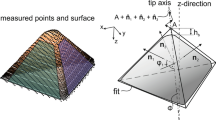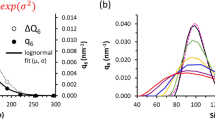Abstract
Colocalisation, the overlap of subcellular structures labelled with different colours, is a key step to characterise cellular phenotypes. We have developed a novel bioimage informatics approach for quantifying colocalisation of round, blob-like structures in two-colour, highly resolved, three-dimensional fluorescence microscopy datasets. First, the algorithm identifies isotropic fluorescent particles, of relative brightness compared to their immediate neighbourhood, in three dimensions and for each colour. The centroids of these spots are then determined, and each object in one location of a colour image is checked for a corresponding object in the other colour image. Three-dimensional distance maps between the centroids of differently coloured spots then display where and how closely they colocalise, while histograms allow to analyse all colocalisation distances. We use the method to reveal sparse colocalisation of different human leukocyte antigen receptors in choriocarcinoma cells. It can also be applied to other isotropic subcellular structures such as vesicles, aggresomes and chloroplasts. The simple, robust and fast approach yields superresolved, object-based colocalisation maps and provides a first indication of protein–protein interactions of fluorescent, isotropic particles.






Similar content being viewed by others
Abbreviations
- 2D:
-
Two-dimensional
- 3D:
-
Three-dimensional
- AU:
-
Arbitrary unit
- DAPI:
-
4′,6-Diamidino-2-phenylindole
- FRET:
-
Förster resonance energy transfer
- GUI:
-
Graphical User Interface
- HLA:
-
Human leukocyte antigen
- LoG:
-
Laplace of Gaussian
- MHC:
-
Major histocompatibility class
- PMT:
-
Photomultiplier tube
- PSF:
-
Point spread function
- SNR:
-
Signal-to-noise ratio
- LUT:
-
Look-up table
References
Anderson CM, Georgiou GN, Morrison IE, Stevenson GV, Cherry RJ (1992) Tracking of cell surface receptors by fluorescence digital imaging microscopy using a charge-coupled device camera. Low-density lipoprotein and influenza virus receptor mobility at 4 degrees C. J Cell Sci 101:415–425
Ayers GR, Dainty JC (1988) Iterative blind deconvolution method and its applications. Opt Lett 13:547
Biggs D (2010) 3D deconvolution microscopy. Curr Protoc Cytom, Chapter 12: Unit 12.19.1–20
Bolte S, Cordelières FP (2006) A guided tour into subcellular colocalization analysis in light microscopy. J Microsc 224:213–232
Clements CS, Kjer-Nielsen L, Kostenko L, Hoare HL, Dunstone MA, Moses E, Freed K, Brooks AG, Rossjohn J, McCluskey J (2005) Crystal structure of HLA-G: a nonclassical MHC class I molecule expressed at the fetal-maternal interface. Proc Natl Acad Sci USA 102(9):3360–3365
Cooper J, Dealtry G, Ahmed MA, Arck P, Klapp B, Blois S, Fernández N (2007) An impaired breeding phenotype in mice with a genetic deletion of beta-2 microglobulin and diminished MHC class I expression: role in reproductive fitness. Biol Reprod 77:274–279
Costes S, Daelemans D, Cho E, Dobbin Z, Pavlakis G, Lockett S (2004) Automatic and quantitative measurement of protein–protein colocalization in live cells. Biophys J 86:3993–4003
Fernández N, Cooper J, Sprinks M, AbdElrahman M, Fiszer D, Kurpisz M, Dealtry G (1999) A critical review of the role of the major histocompatibility complex in fertilization, preimplantation development and feto-maternal interactions. Hum Reprod update 5:234–248
Haralick R, Shapiro L (1992) Accuracy. Addison-Wesley Longman Publishing Co Inc., Chicago
Hess ST, Gould TJ, Gudheti MV, Maas SA, Mills KD, Zimmerberg J (2007) Dynamic clustered distribution of hemagglutinin resolved at 40 nm in living cell membranes discriminates between raft theories. Proc Natl Acad Sci USA 30(104(4)):17370–17375
Holmes T (1988) Maximum-likelihood image restoration adapted for noncoherent optical imaging. J Opt Soc Am A 5:666–673
Holmes TJ, Bhattacharyya S, Cooper JA, Hanzel D, Krishnamurthi V, Lin W, Roysam B, Szarowski DH, Turner JT (1995) Light Microscopic Images Reconstructed by Maximum Likelihood Deconvolution. In: Pawley J (ed) The handbook of biological confocal microscopy, 2nd edn. Plenum Press, New York, pp 389–402
Holmes TJ, Biggs D, Abu-Tarif A (2006) Blind deconvolution. In: Pawley J (ed) Handbook of biological confocal microscopy. Springer Science+Business Media LLC, NY, pp 468–487
Ishitani A, Sageshima N, Lee N, Dorofeeva N, Hatake K, Marquardt H, Geraghty DE (2003) Protein expression and peptide binding suggest unique and interacting functional roles for HLA-E, F, and G in maternal-placental immune recognition. J Immunol 171(3):1376–1384
Jurisicova A, Casper RF, MacLusky NJ, Mills GB, Librach CL (1996) HLA-G expression during preimplantation human embryo development. Proc Natl Acad Sci USA 93:161–165
Kozubek M, Matula P (2000) An efficient algorithm for measurement and correction of chromatic aberrations in fluorescence microscopy. J Microsc 200(Pt 3):206–217
Kuhn HW (1955) The Hungarian method for the assignment problem. Nav Res Logist 2(1–2):83–97
Lachmanovich E, Shvartsman DE, Malka Y, Botvin C, Henis YI, Weiss AM (2003) Co-localization analysis of complex formation among membrane proteins by computerized fluorescence microscopy: application to immunofluorescence co-patching studies. J Microsc 212:122–131
Lacoste TD, Michalet X, Pinaud F, Chemla DS, Alivisatos AP, Weiss S (2000) Ultrahigh-resolution multicolor colocalization of single fluorescent probes. Proc Natl Acad Sci USA 97:9461–9466
Landmann L, Marbet P (2004) Colocalization analysis yields superior results after image restoration. Microsc Res Tech 64(2):103–112
Li Q, Lau A, Morris T, Guo L, Fordyce C, Stanley E (2004) A syntaxin 1, Galpha(o), and N-type calcium channel complex at a presynaptic nerve terminal: analysis by quantitative immunocolocalization. J Neurosci 24:4070–4081
Malkusch S, Endesfelder U, Mondry J, Gelléri M, Verveer P, Heilemann M (2012) Coordinate-based colocalization analysis of single-molecule localization microscopy data. Histochem Cell Biol 137:1–10
Manders EM, Stap J, Brakenhoff GJ, van Driel R, Aten JA (1992) Dynamics of three-dimensional replication patterns during the S-phase, analysed by double labelling of DNA and confocal microscopy. J Cell Sci 103(Pt 3):857–862
Manders EMM, Verbeek FJ, Aten JA (1993) Measurement of co-localization of objects in dual-colour confocal images. J Microsc 169:375–382
Marquardt D (1963) An algorithm for least-squares estimation of nonlinear parameters. J Soc Ind Appl Math 11:431–441
Model MA, Fang J, Yuvaraj P, Chen Y, Zhang Newby B-MM (2011) 3D deconvolution of spherically aberrated images using commercial software. J Microsc 241(1):94–100
Morrison I, Karakikes I, Barber R, Fernández N, Cherry R (2003) Detecting and quantifying colocalization of cell surface molecules by single particle fluorescence imaging. Biophys J 85:4110–4121
Nyquist H (1928) Certain topics in telegraph transmission theory. Trans Am Inst Electr Eng 47:617–644
Obara B, Byun J, Fedorov D, Manjunath BS (2008) Automatic nuclei detection and dataflow in Bisquik system. Workshop on Bio-Image Informatics: Biological Imaging, Computer Vision and Data Mining. Santa Barbara
Pawley JB (2006) Points, pixels, and gray levels: digitizing image data. In: Pawley JB (ed) Handbook of biological confocal microscopy. Springer Science+Business Media LLC, NY, pp 59–79
Pertsinidis A, Zhang Y, Chu S (2010) Subnanometre single-molecule localization, registration and distance measurements. Nature 466:647–651
Pike LJ (2006) Rafts defined: a report on the keystone symposium on lipid rafts and cell function. J Lipid Res 47:1597–1598
Preibisch S, Saalfeld S, Schindelin J, Tomancak P (2010) Software for bead-based registration of selective plane illumination microscopy data. Nat Methods 7(6):418–419
Press W, Flannery B, Teukolsky S, Vetterling W (1992) Numerical recipes in C: the art of scientific computing, 2nd edn. Cambridge University Press, Cambridge
Rasband WS (1997) ImageJ. U. S. National Institutes of Health, Bethesda, Maryland
Rouas-Freiss N, Gonçalves R, Menier C, Dausset J, Carosella E (1997) Direct evidence to support the role of HLA-G in protecting the fetus from maternal uterine natural killer cytolysis. Proc Natl Acad Sci 94:11520–11525
Schindelin J, Arganda-Carreras I, Frise E, Kaynig V, Longair M, Pietzsch T, Preibisch S, Rueden C, Saalfeld S, Schmid B, Tinevez J-Y, White D, Hartenstein V, Eliceiri K, Tomancak P, Cardona A (2012) Fiji: an open-source platform for biological-image analysis. Nat Methods 9:676–682
Schneider C, Rasband W, Eliceiri K (2012) NIH Image to ImageJ: 25 years of image analysis. Nat Methods 9:671–675
Schütz GJ, Trabesinger W, Schmidt T (1998) Direct observation of ligand colocalization on individual receptor molecules. Biophys J 74(5):2223–2226
Shaikly VR, Morrison IE, Taranissi M, Noble CV, Withey AD, Cherry RJ, Blois SM, Fernández N (2008) Analysis of HLA-G in maternal plasma, follicular fluid, and preimplantation embryos reveal an asymmetric pattern of expression. J Immunol 180(6):4330–4337
Shaikly V, Shakhawat A, Withey A, Morrison I, Taranissi M, Dealtry G, Jabeen A, Cherry R, Fernández N (2010) Cell bio-imaging reveals co-expression of HLA-G and HLA-E in human preimplantation embryos. Reprod Biomed Online 20:223–233
Shannon CE (1949) Communication in the presence of noise. In: Proceedings of the IRE vol 37, pp 10–21
Sibarita JB (2005) Deconvolution microscopy. Adv Biochem Eng Biotechnol 95:201–243
Sprott JC (2003) Chaos and time-series analysis. Oxford University Press, Oxford
Thévenaz P, Ruttimann UE, Unser M (1998) A pyramid approach to subpixel registration based on intensity. IEEE Trans Image Process 7:27–41
Thompson R, Larson D, Webb W (2002) Precise nanometer localization analysis for individual fluorescent probes. Biophys J 82:2775–2783
Verveer PJ, Bastiaens PI (2008) Quantitative microscopy and systems biology: seeing the whole picture. Histochem Cell Biol 130(5):833–843
Wolter S, Schüttpelz M, Tscherepanow M, Van de Linde S, Heilemann M, Sauer M (2010) Real-time computation of subdiffraction-resolution fluorescence images. J Microsc 237:12–22
Zinchuk V, Zinchuk O, Okada T (2007) Quantitative colocalization analysis of multicolor confocal immunofluorescence microscopy images: pushing pixels to explore biological phenomena. Acta Histochem Cytochem 40:101–111
Acknowledgments
We would like to thank the three anonymous reviewers for critical comments and pivotal suggestions, and J.A. Laissue, N. Kad and B. Amos for helpful discussions.
Author information
Authors and Affiliations
Corresponding authors
Electronic supplementary material
Below is the link to the electronic supplementary material.
Rights and permissions
About this article
Cite this article
Obara, B., Jabeen, A., Fernandez, N. et al. A novel method for quantified, superresolved, three-dimensional colocalisation of isotropic, fluorescent particles. Histochem Cell Biol 139, 391–402 (2013). https://doi.org/10.1007/s00418-012-1068-3
Accepted:
Published:
Issue Date:
DOI: https://doi.org/10.1007/s00418-012-1068-3




